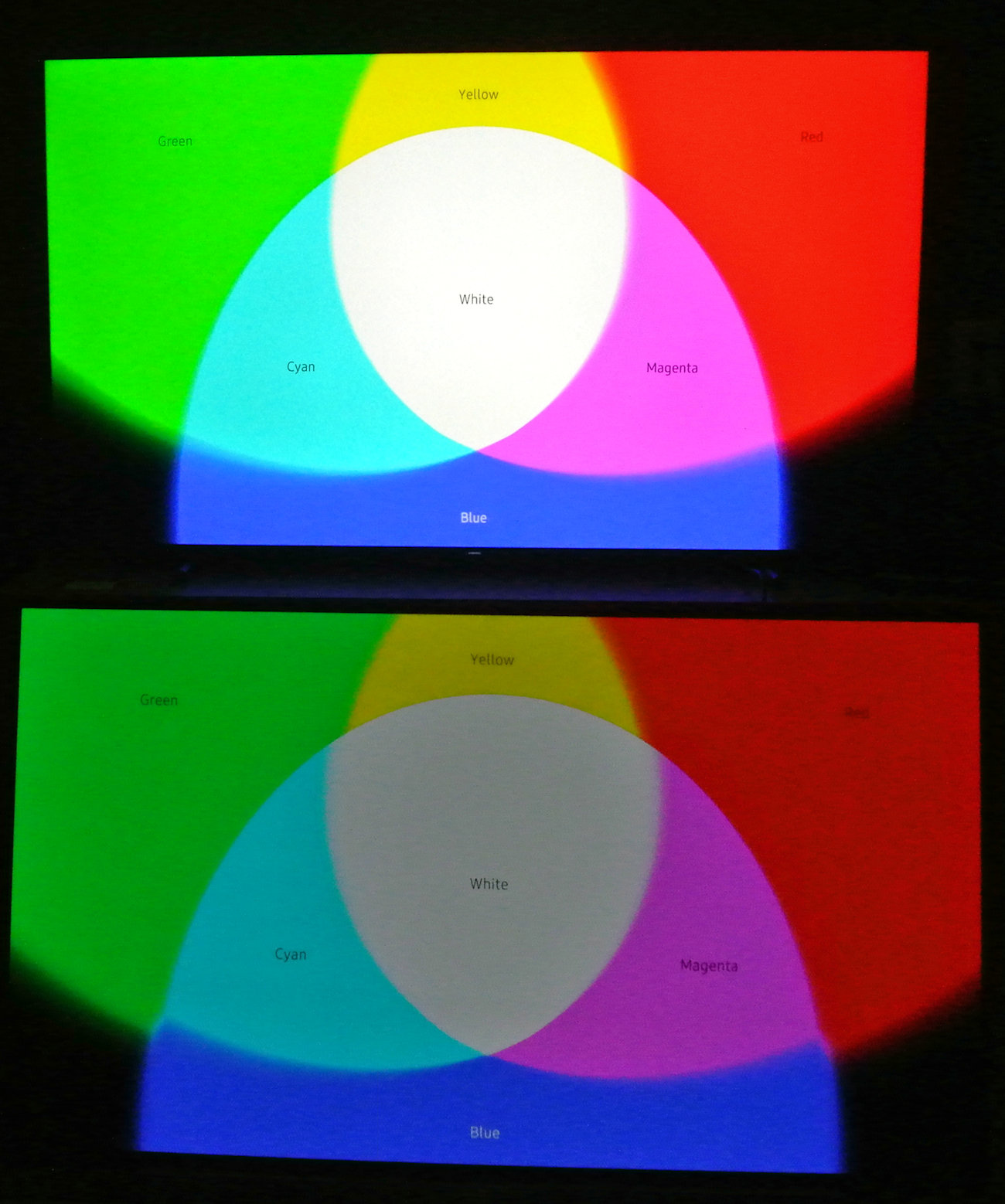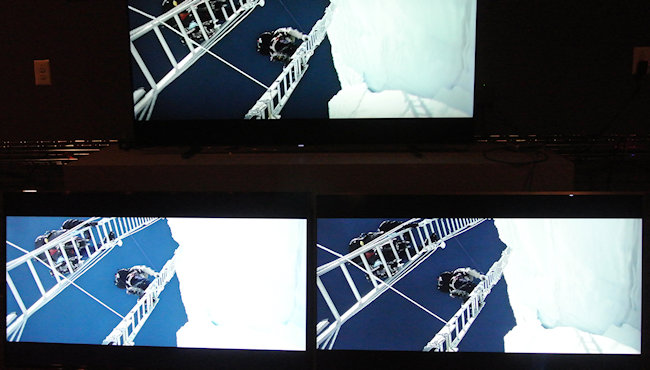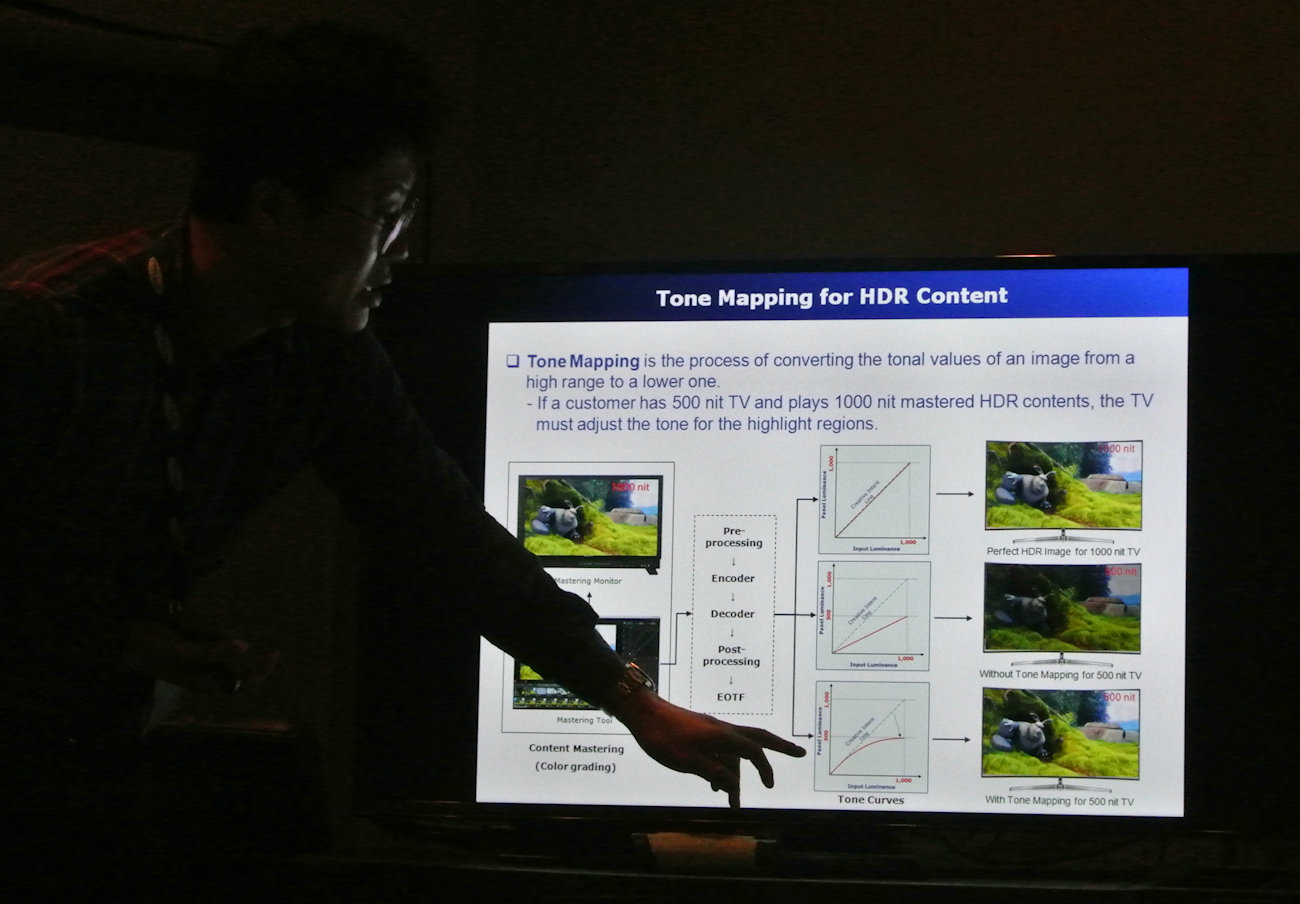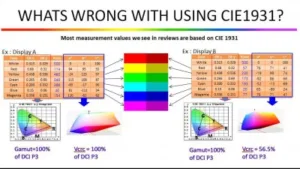Two weeks ago, I reported on the talk Gerard Catapano gave at the SID LA Chapter’s annual One-Day Conference (Two Keys to Optimal HDR TVs: Dynamic HDR Metadata and Tone Mapping). After his presentation, Catapano, who is Director of Quality Assurance at Samsung’s QA Lab, and I started talking, and he invited me to visit the lab in central New Jersey.

The focus of the presentations and demos was on color spaces, tone mapping, and HDR TVs, as was the portion of Catapano’s SID-LA talk I described two weeks ago. But with five people providing presentations and insight, and with actual TV sets for comparisons, the subject was explored in more depth.
Samsung, along with many color scientists, would like us to look at the universe of visible colors and the sub-sets of these colors (color gamuts) rendered by different displays in a three-dimensional color space. That makes a lot of sense, but the most common way of looking at visible colors and color gamut is still with the 85-year-old CIE 1931 color diagram, which collapses the luminance (“brightness”) z-axis so that the volumetric color space is pressed into a plane. That’s a simplified way of looking at color gamut that many of us have become used to, but it obscures the fact that the two-dimensional gamut of any display changes as luminance changes. As you move toward white on one end of the L* (luminance) axis or toward black on the other, the universe of visible colors shrinks and so do the color gamuts of TVs and other display devices.
With the much larger range of L* available high dynamic range (HDR) TVs, maximizing the gamut at high and low values of L* becomes an important contributor to image quality. For instance, are colors visible in high-brightness scenes, or are they washed out in a sea of white?
Over the years many two- and three-dimensional color spaces have been developed, with various ways of coding colors on a variety of axes. The CIE 1976 LAB color space is widely used, and is the one on which Samsung based part of its discussion. The space takes its name from its three axes: L* (luminance), a* (redness-greeness), and b* (yellowness-blueness).
 The CIE 1976 LAB Color Space. (Figure: CIE)
The CIE 1976 LAB Color Space. (Figure: CIE)
Quality Assurance Manager Chris Andrade showed data from actual products that indicated the products had nearly equal coverage of the DCI P3 color space when compared on the two-dimensional CIE 1931 diagram, but differed signficantly when their color volumes were compared. The difference between the two color volumes represent colors that cannot be displayed on the less capable display. Because OLED HDR TVs are only capable of about half the maximum luminance of the best QD-enhanced LCD HDR TVs, they render a significantly smaller color volume (which the folks at the QA lab were pleased to point out).
 Top: Photo of new Samsung Q9 QLED TV (top) and LG Signature OLED bottom. The photo exaggerates the darkness of the OLED TV somewhat, but it was very much darker that the quantum-dot enhanced set. Luminance of the QLED set was roughly twice as much as the OLED. The blacks on the OLED were blacker, but you had to look hard to tell the difference. (Photo: Ken Werner)
Top: Photo of new Samsung Q9 QLED TV (top) and LG Signature OLED bottom. The photo exaggerates the darkness of the OLED TV somewhat, but it was very much darker that the quantum-dot enhanced set. Luminance of the QLED set was roughly twice as much as the OLED. The blacks on the OLED were blacker, but you had to look hard to tell the difference. (Photo: Ken Werner)

Now, what happens when a film produced with a maximum luminance of 1000 cd/m² is shown on an HDR TV that is only capable of producing 500 cd/m²? If the set supports static metadata, which means that the metadata describing the film’s characteristics is the same for the entire work, a likely solution is to reduce the luminance by half. This solves the problem for those scenes that actually contain 1000 cd/m² areas, but overly compresses the scenes whose brightest areas are not this bright. The effect is likely to be extremely disappointing to the film’s director, as well as to the set’s owner if he is able to compare his image to the director’s intent.
If the film is encoded with dynamic metadata, which varies from scene to scene, and the set can support it, the color volume can be reduced optimally for each scene, producing images which are much closer to the director’s intent, a process called tone mapping. Senior Engineer Mindoo Chun said that Samsung developed the dynamic-metadata and tone-mapping technologies to work in conjuction with the HDR10 high dynamic range profile, and made them freely available. The technologies have been embedded in SMPTE standard ST.2094-40. Catapano said that all of Samsung’s HDR TVs for the 2017 model year area ST.2094-40 ready.
 Tone mapping works. A 1000-nit image on a Samsung QLED Q9 TV, looking much as the director intended it to look (top), a Samsung MU7000 TV at 500 cd/m² without dynamic metadata (lower left), and a Samsung KU7000 TV at 500 cd/m² with dynamic metadata (lower right). The 500 cd/m² image with dynamic metadata approximates the director’s intent much more closely. (Photo: Ken Werner)
Tone mapping works. A 1000-nit image on a Samsung QLED Q9 TV, looking much as the director intended it to look (top), a Samsung MU7000 TV at 500 cd/m² without dynamic metadata (lower left), and a Samsung KU7000 TV at 500 cd/m² with dynamic metadata (lower right). The 500 cd/m² image with dynamic metadata approximates the director’s intent much more closely. (Photo: Ken Werner)
 Mindoo Chun explains some of the subtleties of tone mapping. The proper rendering of each curve for each type of scene is critical. (Photo: Ken Werner) Click for higher resolution
Mindoo Chun explains some of the subtleties of tone mapping. The proper rendering of each curve for each type of scene is critical. (Photo: Ken Werner) Click for higher resolution
Anyone Can Use the QLED Term?
As is now well known, Samsung is calling its new generation of quantum-dot TV sets “QLED,” which the company defines as “a display device using quantum dots.” (Samsung Gives a Good TV a Bad Name — Again) Given the significant effort that Samsung expended in establishing the QLED and Q brands at CES, I was surprised when Andrade said that “anyone can use the QLED name.” Samsung, he said, wants to establish QLED as a category.”
Why make public an expensively established brand and Samsung’s very effective tone-mapping technology? My speculation is that this is total war, QLED vs. OLED, Samsung wants to marginalize OLED and keep its market penetration low until Samsung can introduce electroluminescent QLED. If HDR QLED dominates the industry, Samsung, as the largest seller of TVs, will do just fine.
Ken Werner is Principal of Nutmeg Consultants, specializing in the display industry, manufacturing, technology, and applications, including mobile devices and television. He consults for attorneys, investment analysts, and companies re-positioning themselves within the display industry or using displays in their products. He is the 2017 recipient of the Society for Information Display’s Lewis and Beatrice Winner Award. You can reach him at [email protected].

